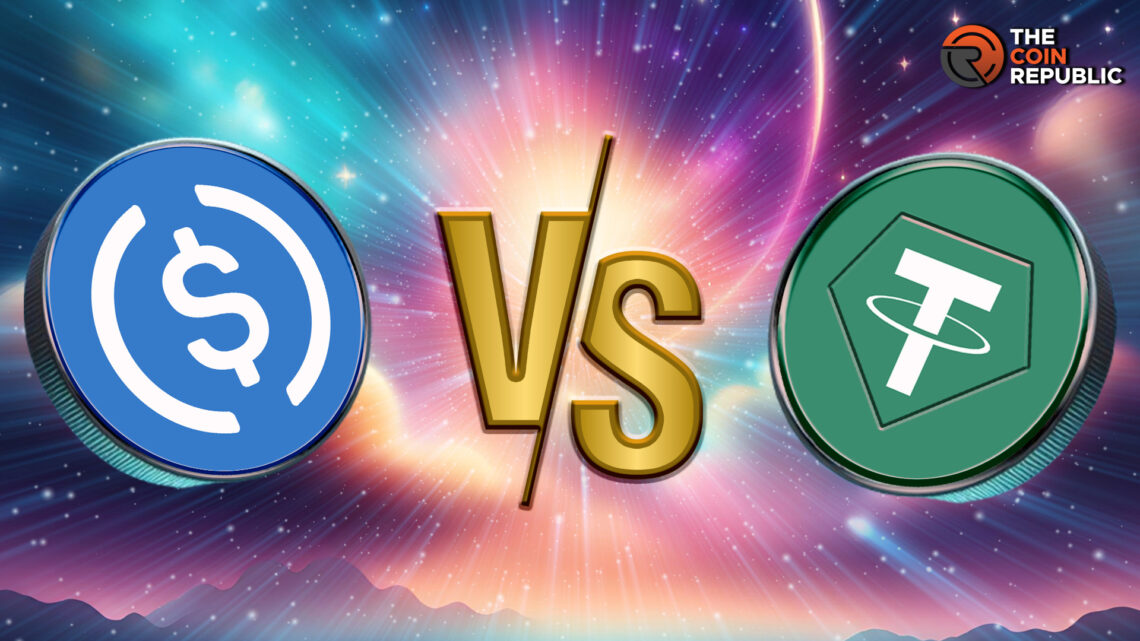- 1 Stablecoins like USDT and USDC offer crypto trading stability by pegging to fiat currencies.
- 2 While USDT currently dominates in liquidity, USDC scores higher on compliance and transparency.
As crypto assets continue grappling with high volatility, stablecoins have emerged as a way for traders to avoid wild value swings. By pegging cryptocurrencies to real-world assets like fiat money, stablecoins try to preserve principal despite crypto market turbulence.
In 2024, Tether’s USDT and Circle’s USDC have surfaced as the most popular dollar-backed stablecoins.
This guide will explore their essential traits and contrasting metrics like adoption rate, reserves, regulation adherence, and redemption processes.
What is USDT (Tether)?
Tether USD, or USDT, is a cryptocurrency tied to the US dollar and issued by Tether Limited. USDT, the world’s oldest and largest stablecoin, has a market valuation of more than $95 billion as of January 2024.
USDT is a stablecoin tied to real-world fiat money, the US dollar, 1:1.
Tether, the issuer, claims that all USDT tokens are 100% guaranteed by US dollar reserves, which include US treasury bills, overnight reverse repurchase agreements, money market funds, corporate bonds, precious metals, Bitcoin (BTC), secured loans, and cash.
USDT is available on popular blockchain networks such as Ethereum (ETH), Tron (TRX), Solana (SOL), Avalanche (AVAX), Cosmos (ATOM), and Tezos (XTZ).
What is USDC (USD Coin)?
USD Coin, or USDC, is a cryptocurrency tethered to the US dollar. USDC is the world’s second-largest stablecoin, having a market worth of more than $25 billion as of January 2024.
USDC was created in 2018 by a consortium known as Centre, which Circle and Coinbase founded. In 2023, Circle absorbed the Centre consortium and became the sole USDC issuer. Coinbase acquired an undisclosed stock share in Circle as part of the purchase.
Circle and Coinbase released USDC when the CFTC charged USDT issuer Tether with failing to correctly back its stablecoins with US dollar reserves, as indicated earlier.
USDC marketed itself as the most secure stablecoin on the market, with regulated and fully guaranteed reserves. Circle encourages transparency by releasing attested information on USDC reserve holdings every week.
Comparing USDC and USDT
USDC and USDT are fiat-collateralized stablecoins pegged to the US dollar and share similar properties. They are helpful for ordinary payments and work with multiple blockchains, making them more accessible. Stablecoins may be easily and quickly moved from one peer to another, but specific fundamental characteristics make it easier to pick between them.
- Market Cap: USDC currently has a market cap of around $27 billion, while USDT has a larger market cap of approximately $83.7 billion. This difference in market cap reflects the higher trading volume and liquidity of USDT.
- Backing: Both stablecoins are backed by assets to maintain their stable value. USDC is backed by cash and cash equivalents, while USDT’s reserves include cash, treasuries, and liquid debt.
- Regulation: USDC is fully regulated and complies with US anti-money laundering and know-your-customer regulations. The US government consistently regulates it. In contrast, USDT has faced some regulatory challenges, leading to questions about its compliance.
Advantages of USDT
- Longevity: USDT has been in use for longer, making it more widely adopted and trusted.
- Trading volume and availability: USDT has a higher trading volume and is available on multiple markets, enhancing its liquidity.
- Liquidity: With its large market cap, USDT offers high liquidity, minimizing price fluctuations.
- Market sentiments: Many traders prefer USDT due to its longstanding reliability, making it a preferred transaction choice.
Advantages of USDC
- Transparency and regulatory compliance: USDC adheres to US government regulations, providing greater transparency and protection against financial crime.
- Simplified reserves: USDC’s reserves consist solely of cash and equivalents, reducing complexity and potential risks compared to USDT.
- Redemption process: USDC offers a more straightforward redemption process with no caps or verification fees, making it more user-friendly than USDT.
Concluding Thoughts
In closing, stablecoins like USDT and USDC fulfill a profound need in crypto’s volatile landscape – a dependable medium for payments and trading. Both prominent dollar-pegged tokens have carved their niches based on adoption history, compliance rigor, and transparency.
As this promising asset class matures and interfaces further with mainstream finance, USDC, and USDT represent blueprints for the bedrock stablecoins of the future that global economies will rely upon. Their current real-world utility and resilience already provide glimpses into this stablecoin-powered vision unfolding.
Anurag is working as a fundamental writer for The Coin Republic since 2021. He likes to exercise his curious muscles and research deep into a topic. Though he covers various aspects of the crypto industry, he is quite passionate about the Web3, NFTs, Gaming, and Metaverse, and envisions them as the future of the (digital) economy. A reader & writer at heart, he calls himself an “average guitar player” and a fun footballer.


 Home
Home News
News






